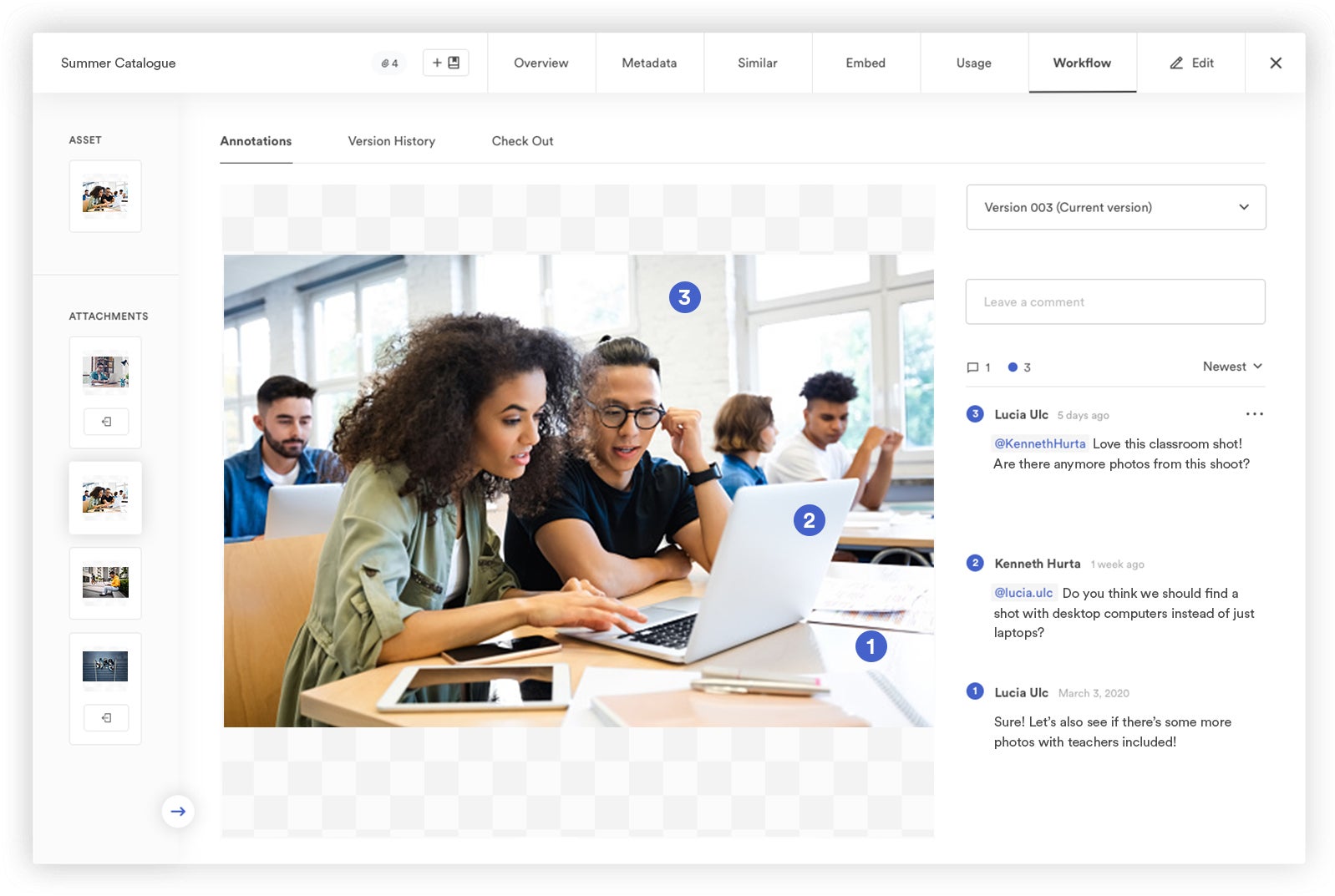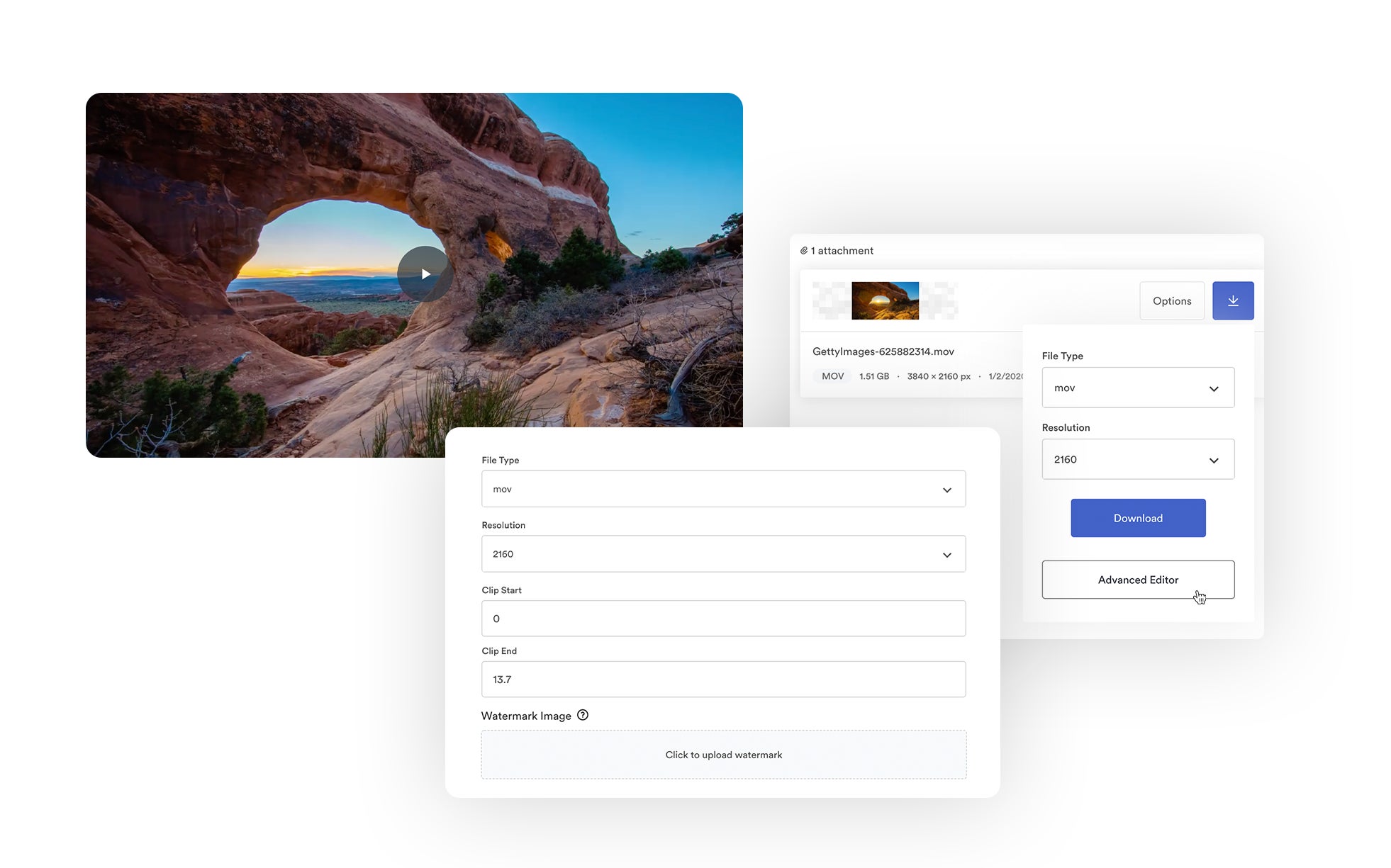Get branding tips and expert advice delivered straight to your inbox.
Digital asset management software (DAM) and document management software (DMS) are often confused because they have overlapping functionality; both serve as secure cloud storage solutions to manage business collateral. But their differences lie in the type of collateral they are best suited to store and manage.
Our post talks about each software — digital asset management vs. document management — with clear definitions and recommendations for each solution, so you can find what’s best for your business.
Let’s get started!
You can also explore our digital asset management solution, Brandfolder, and learn more about DAM features and functionality by scheduling a free demo with our team.
Digital Asset Management Systems: Definitions, Features & Recommendation
DAM systems serve as a single source of truth for all of your brand assets — this includes everything from documents, spreadsheets, forms and images, to rich media files like audio files, videos, design files, 3D assets, templates, marketing materials, sales collateral, social media content, and more. There are digital asset management solutions for all business sizes, but this investment only makes sense if you have the wide range of collateral that DAMs accept.
Let’s talk more about DAM features and how they’re different from document management systems.
DAM Features
Cloud-based storage: Digital asset management software (like Brandfolder) accepts hundreds of file formats and hosts all of your brand’s collateral in a secure cloud environment. Your files are accessible and performant no matter where or how users access content. Plus, Brandfolder’s flexibility enables you to centralize digital content; instead of using one storage solution for business documents, another for images and videos, another for design files, and so on.
Metadata tagging: DAMs are unique from DMS because they can analyze and extract more detailed metadata from your assets. All of this metadata is stored at the asset level for easy reference (and you can use custom fields to enable more in-depth information management). Plus, metadata powers search and discovery so you can find content without having to search by folder or file name.
Artificial intelligence (AI) & automation: The AI in DAM software simplifies asset management and improves brand consistency — it detects duplicate content, adds metadata and tags to assets, allows you to manage the entire asset lifecycle and set expirations for assets, maintains version control, automates global updates, and more.
Advanced search: DAMs have a flexible search feature so you can retrieve content in several ways. You can search by term, create custom pins and filters, or sort results by file type. You can find the files you’re looking for and see new content that is approved for projects.
Permissions: Easily share files with other team members and restrict access control. You can monitor and update permissions at any time.
Online share links: Send digital files to people outside of your organization and monitor content once it’s been sent. You can update share link settings, add and remove files, expire content (or entire share links) and set notifications for share link activity.
Integrations & API: DAMs integrate with the other tools in your daily operations (like content management systems, graphic design tools, eCommerce sites, PIM systems, etc.) so you can use the software in sync. Brandfolder even integrates with DMS like Templafy so you can create, distribute, sign, finalize, and manage business documents like contracts, SOWs, and proposals.
Reporting & analytics: DAMs provide in-depth data and analytics on asset usage and user activity so you can understand what team members and stakeholders do in the DAM, which content is most popular amongst users, and which content is “buried” or goes unused.
Digital asset management software is also a little more robust than DMS solutions because they contain features to not only manage your existing collateral but to support new content creation and ease designer burden. These include:
- Native collaboration tools: Designers can efficiently update existing content; receive and manage new creative requests; work with other creatives and admins to achieve (approved) end products.

- Digital transformation tools: Users can easily convert file formats, optimize file resolution, crop content, and make video clips or GIFs before downloading or publishing media assets.

- Content automation: Non-creatives can use (and reuse) approved templates to create on-brand collateral for unique use cases. You can create templates to support all of your teams and projects. For example, marketing teams can use content automation to create new promotional materials, like newsletters, in bulk. Sales teams can create new brochures, whitepapers, or business cards. Admins can create business proposals and contracts. The list goes on...

- Content delivery network & web-to-print functionalities: DAMs like Brandfolder have a native CDN and web-to-print integrations, so you can manage online publishing and print projects in the DAM. You can easily embed assets online and maintain consistency across all digital touchpoints, and send custom print orders to any print service.

- Brand guidelines: Many DAMs have a dashboard (like Brandfolder’s Brandguide) where brand managers can publish rules and guidelines for how to use business collateral. You can typically build these out in any way that best fits your business; for example, you can include details on how to use certain types of collateral and where to publish content online, instructions on approval processes, and any pertinent rights management information.
Read more: Why DAM Is Essential to Support Brand Management Strategies
Recommendation
DAMs are recommended for businesses that:
- Have “grown out” of standard cloud storage drives (think Google Drive, Microsoft OneDrive, Dropbox or Box) and need upgraded features to maintain organization and control in their content library.
- Manage a high volume of digital content and need to keep everybody on the same page.
- Require the flexibility of DAM software to support all of your users and store the different types of collateral your brand produces.
- Need easier ways to retrieve content and improve asset accessibility.
- Anticipate future growth and want a solution that can scale with their business requirements.
Think DAM is right for you? Learn about the most popular DAM software brands in our guide: 5 Best Digital Asset Management Vendors for 2023 + Reviews
Document Management Systems: Definition, Features & Recommendation
Document management systems are a simpler solution when compared to DAM platforms — as the name suggests, DMS lets you store digital files like business documents, PDFs, spreadsheets, technical spec sheets, contact forms, contracts and proposals, and more.
DMS have advanced features to help you clearly organize files, maintain organization, track version history, collaborate with other team members, and streamline file sharing — but they do not accept as many file types as DAM systems. Nor do they have all the same functionality.
Some examples of document management systems include Google Drive, Microsoft Sharepoint, OneDrive, Dropbox Business, Box, Docuware, and eFileCabinet.
If you need a solution to manage (i.e., create, distribute, control, sign, and track) business documents, then a DMS will work for you. But if you also have design files and other rich media to account for, then you’re better off looking at a digital asset management platform.
DMS Features
Cloud storage with flexible organization: Document management systems provide secure and scalable cloud storage for business files (as discussed above). But some systems are more user-friendly because they allow you to customize the layout of your file library, drag and drop files to move them, and oversee new uploads.
Compliance features: These features give you clearer ways to manage data storage so you can comply with HIPAA, SEC, GDPR, and other regulations.
Mobile access: Most DMS have mobile apps so you can easily access important business collateral from any device.
Powerful search: Retrieve content by searching the file name, date created, last updated date, author name, or metadata details. Some DMS have a more robust search feature that can analyze the text and content in your files to pull everything that relates to your query.
Document linking: Some DMS allow you to link files that are stored in different locations so users can easily jump from one relevant resource to the next. (DAMs mitigate this issue by allowing you to store content in multiple places and create asset containers.)
Native editing and collaborative tools: Make instant edits to files, or comment with other team members on updates to business collateral. Then, you can check out files to make changes (and check files back in for approval).
Version history (or audit trails): Store and track all versions of your business collateral to see exactly what changes were made, when, and by whom. You can also restore previous versions of your files.
User permissions and file locking: As mentioned with DAM systems, DMS have user permissions so you can share files with other team members and control what they can do with content. These systems also have file-locking features so you can restrict user activity at the file level.
Online sharing: DMS systems have features like custom share links and portals where you can send individual files or groups of files to end-users. Then, you can monitor all online sharing and keep track of who has access to your business documents.
Workflow automation: Similar to DAM, DMS solutions have automation rules so you can streamline document routing, instantly make updates to files, and automate other repetitive tasks.
Templating: Advanced DMS solutions typically have templating tools so you can share approved templates with team members and stakeholders. Then, other users can create new business documents on the fly (while adhering to business and regulatory compliance requirements).
Notifications: Admins can set alerts so they’re notified when users upload new files, edit existing files, view content, etc. This allows them to oversee DMS activity and make sure everybody is using business collateral appropriately.
Integrations: Document management systems have native integrations with other software so you can connect the tool with applications like Google or Microsoft and push files between systems. Many DMS also integrate with electronic signature apps (like DocuSign) to enable online document signing.
Recommendation
Document management systems are recommended for:
- Teams that primarily manage the types of business files that DMS accepts (and do not need to store uncommon file types or rich media like videos, design files, 3D models, etc.)
- Managers that need easier ways to oversee new contracts and proposals, and easily collaborate with partners and clients.
- Businesses that need to improve the findability and usability of their existing collateral.
- Teams that need a solution that has strong integrations with workplace apps, like Microsoft Office and Google, and electronic signature apps.
But it’s worth noting: you may check some of the boxes above and still be a better fit for digital asset management software. Keep reading to learn more about how enterprise cloud storage providers and DAM software compare.
Learn More About Brandfolder’s DAM Solution
While DAM and DMS solutions have similar features and functionality, they cater to different user needs. Some businesses and professionals can get away with simply using DMS to manage documents. However, most teams find that they eventually require DAM software to manage their entire library of digital content because it’s more flexible, versatile, and scalable.
If you’re interested in learning more about DAM software, how it compares to document management software, and our solution, Brandfolder, you can schedule a free demo and consultation with our team.
Related reads:
